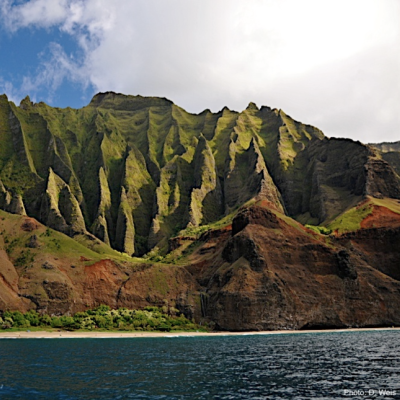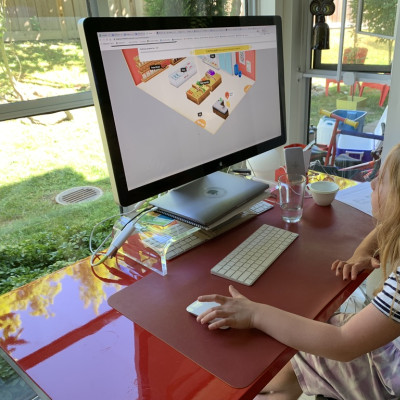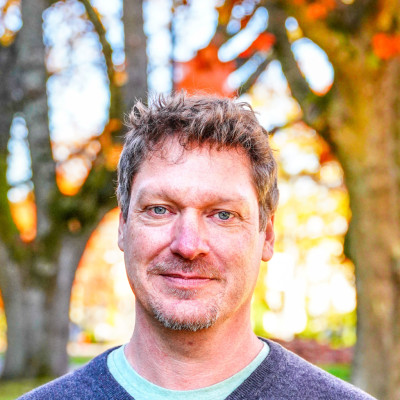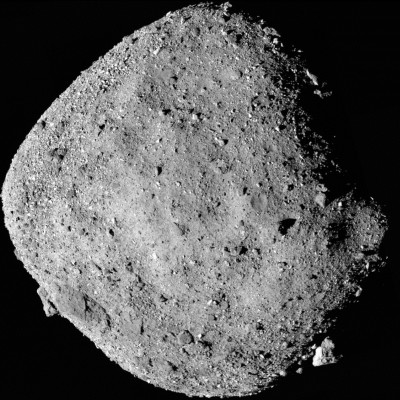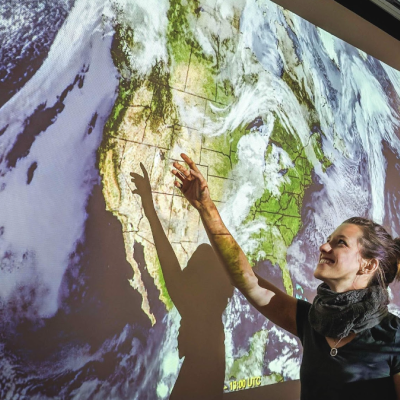News
Stay up-to-date with what's happening in EOAS
Meet Elisabeth Giroud Proeschel — Planetary Scientist
Elisabeth (Ellie) Giroud Proeschel is a Master student in Geophysics and a Planetary Scientist at the University of British Columbia (UBC), where she studies a landform unique to Mercury called hollows. She focuses on those occurring at impact craters and whether a relationship can be derived between relative crater age and hollow locations within their host craters in order to better understand how hollows form, grow and "die" on Mercury. Ellie completed her undergraduate degree in Geology in France before moving to BC where she can now be found roaming the mountains in her spare time.
New research! Geochemical analysis of Kaua’i reveals changes in the composition of the Hawaiian mantle plume
This week The Pacific Center for Isotopic and Geochemical Research (PCIGR) has a new article out in the American Geophysical Union journal, Geochemistry, Geophysics, Geosystems. The article, authored by Nicole Williamson, Dominique Weis, James Scoates, and Michael Garcia, is the culmination of years of extensive sampling and careful geochemical analyses of volcanic rocks from Kaua’i.
The Hawaiian islands were formed by the movement of the Pacific Plate over the Hawaiian Mantle plume, creating a series of volcanic islands. The recent work by the PCIGR reveals that the island of Kaua’i formed during a transitional period as the geochemical composition of the Hawaiian mantle plume evolved. The analysis of this new geochemical dataset demonstrates that older volcanic rocks in western Kaua‘i have a different geochemical signature than younger rocks in eastern Kaua‘i. Importantly, this work has tracked and quantified an important geochemical reference point, the Average Loa (‘ALOA'), in the Hawaiian mantle source. This study provides an example of how volcanic rocks at the surface of such oceanic islands can provide information on the spatial and temporal changes in deep mantle geochemistry.
To read the original article, "Emergence of the Loa Mantle Component in the Hawaiian Islands Based on the Geochemistry of Kaua’i Shield-Stage Basalts”, click here. All elemental and isotopic data compiled from Hawaiian volcanoes used in this work and renormalized to the same laboratory standards are available in a publicly accessible database.
Play Climate Hero - An online game that combines AI with climate education
The EOAS's Pacific Museum of Earth has recently launched a new version of their climate science-themed online escape room game, Climate Hero. This initiative is part of the Pacific Museum of Earth's GenAction grant, supported by the Canadian Association of Science Centres, which is backed by a $6 million investment from the Government of Canada's $37.8 million Climate Action and Awareness Fund, supporting youth-focused climate change projects like GenAction. The PME/EOAS Team (Kirsten Hodge, Eva Gnegy, Lualawi Mareshet Admasu, and Rachel White) collaborated with Steamlabs to develop the game and ECO Schools Canada to promote the game as part of their Eco-Certification program with schools across Canada.
In the game, players start 40 years in the future, when Earth's climate has drastically changed. Players are tasked with navigating through six challenges, journeying back in time to commit to climate action. These challenges encompass various levels of climate action, from individual efforts to policy-level initiatives. A unique AI-feature allows players to engage in critical thinking and conversation, using a large language model powered by Cohere AI to simulate dialogue between players and the game’s characters. As part of this initiative, we've also spotlighted EOAS researchers, Marti Doucet & Rachel White in Science Spotlights, and we’re excited to announce that Rachel’s spotlight was chosen to be featured in the Climate Quest exhibit at Science North.
Click here to learn more about the game and play yourself!
Meet Chris Payne - Oceanographic Technician
Chris Payne is an oceanographic technician at the University of British Columbia (UBC), Department of Earth, Ocean & Atmospheric Sciences. He helps people accomplish their research successfully both in the field and the lab. In addition to maintaining a wide variety of oceanographic and lab equipment, he also maintains the departmental workboat and helps teach the yearly Methods in Oceanography Field Course. He holds a BSC. in Biology from the University of Ottawa and an MSC. in Biology from McGill University. Prior to coming to UBC, Chris held technical roles at McGill University, l’Université de Montréal and the Georgia Institute of Technology.
Bits of Bennu asteroid to arrive at UBC
Original story from UBC Science.
This weekend, samples collected from the Bennu asteroid successfully touched down in the Utah Test and Training Range—a milestone for NASA’s OSIRIS-REx mission and partners at the Canadian Space Agency. UBC has already made major contributions to the mission – a team including UBC planetary scientist Dr. Catherine Johnson used data from the Canadian-designed OSIRIS-REx laser altimeter to help select a safe sampling site.
Now, after evaluation, a portion of that material—potentially dating back to the birth of the solar system roughly 4.5 billion years ago—will be delivered to UBC’s Pacific Centre for Isotopic and Geochemical Research (PCIGR) for analysis. Dr. Dominique Weis, director of the facility, discusses the challenges of providing high-precision, low-level isotopic and geochemical analysis of rock and dust samples from what’s been described as a rubble pile of an asteroid.
To prepare for the arrival of the samples, your lab has been running test analyses on representative meteorites of a composition expected to be close to that of Bennu. What’s involved in that?
"Working on Bennu asteroid samples will be the first time our lab will handle and analyze pristine extraterrestrial material—samples that have come straight from space."
Our team is skilled in performing low-level, high-precision geochemical analyses. This involves careful sample handling to avoid contamination, sample preparation using various chemical techniques, and analysis using state-of-the-art and very sensitive mass spectrometers.
Working on Bennu asteroid samples will be the first time our lab will handle and analyze pristine extraterrestrial material—samples that have come straight from space, not meteorites that have fallen through Earth’s atmosphere, landed on the surface, and been chemically and physically altered.
In close consultation with NASA and the Canadian Space Agency (CSA), we’ve spent the last year optimizing our instruments and practising on representative samples from meteorites (Murchison and Allende) that fell to Earth. These meteorites are closest in composition to what we expect from Bennu. Using these practice samples, our team has devised methods on how best to process the pristine Bennu samples and analyze them for their chemical composition. That allows us to tweak our methods until we have a set procedure that we’re confident in using once the Bennu samples arrive. CSA funding and support has been crucial, as have test meteorite samples provided by the Smithsonian Institution.
PCIGR handles a wide range of terrestrial samples—from honey to volcanic rocks to mineral deposits. Why is PCIGR one of the few Canadian facilities well-positioned to handle these asteroid bits?
To understand a system, whether it’s finding out what’s in our honey, reading the history of volcanic rocks or dating a billion-year-old mineral, we have to characterize their elemental and isotopic compositions. More often than not, just minute quantities of elements and isotopes can define and differentiate one system from another. We’re talking about concentrations in the parts per million to parts per billion – a part per billion is equivalent to one drop of water in an Olympic-sized swimming pool. Our instruments are that sensitive. All this is part of the reason UBC funds PCIGR as a shared research platform, accessible to the wider community for geochemical and geochronological analyses.
With Bennu, asteroid specialists have some idea of what to expect regarding its composition. And we’ve gained some practice with the test meteorite samples. But no one can be fully sure what to expect. Only two other asteroids (Ryugu and Itokawa) have been sampled directly from space, in very minute quantities. Based on this experience, the international research community will conduct as many types of analyses on Bennu samples as possible. The project lead, Dr. Dante Lauretta (University of Arizona) has tasked PCIGR to analyze the samples for low-level elemental concentrations using some highly sensitive instruments, as well as major element compositions. The work will push some of our techniques to levels of precision, reproducibility and chemical detection that we haven’t reached before.
Your lab is focusing on trace and major element analysis of the Bennu samples. What are we hoping to learn, and do you foresee any surprises?
We’ll get powdered samples and subject them to a chemical procedure to reduce them into a liquid solution—the typical format our mass spectrometers can handle. During the preparation, we’ll be processing standard reference materials in parallel with the Bennu samples. Standard reference materials have a known chemical composition that will ensure quality control of our processing and analytical procedures. Because we’re dealing with major and trace elements that are in minute concentrations, we have to be careful about contamination. This means processing the asteroid samples and reference materials in a clean-lab environment. The air in our clean lab and fume hoods respectively has only 1,000 or 100 particles of less than 0.5 microns in diameter per cubic foot. A human hair is about 50 microns in diameter. So, we’re talking about a really clean environment!
Bennu’s constituent materials haven’t undergone significant chemical changes over the past 4.5 billion years. So, finding out what Bennu is made of will give us a window into the early solar system and what gave rise to how our solar system turned out to be. We don’t know what to expect once we start analyzing the samples. We hope to be pleasantly surprised by learning something that we hadn’t expected!
Credit: UBC Science https://science.ubc.ca/news/bits-bennu-asteroid-arrive-ubc
Read & listen more about this story:
EOAS Weather Forecast Research Team key player of the NSF-NSERC Global Centers Initiative
Chances are you are reading this article on a device powered by The Western Interconnected Grid or the “Western Interconnection”. This major electrical transmission network supplies over 80 million people, throughout British Columbia, Alberta, the western United States, and part of Baja Mexico. In the West, fire is one of the primary threats to the infrastructure that supports this power grid. Adapting to increasing fire risks associated with climate change is one of the greatest challenges facing western North America.
The Weather Forecast Research Team, headed by Earth Oceans and Atmospheric Sciences Professor Roland Stull, aims to estimate ‘Probable Max Fire Threat (PMFT) to Future Electric Supply and Transmission’. The team will create and employ numerical weather prediction and climate model downscaling to predict and mitigate potential fire risks. Their work is part of a larger initiative, ‘The US-Canada Center on Climate-Resilient Western Interconnected Grid’, co-lead by the University of Utah and the University of Calgary. This ambitious and critical project has just received a total of $8.75M from the National Science Foundation and Natural Sciences and Engineering Research Council of Canada Global Centers Initiative.
The six Canadian Research teams funded by the Global Centers Initiative are all tackling essential research questions to address climate related challenges and concerns. Click here to read more about the Weather Forecast Research Team and the work they are doing to facilitate climate-adapted infrastructure.

